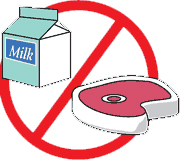 Figures from the US Department of Agriculture show that US per-capita meat consumption declined for four consecutive years from 2006 and 2010, a 6% drop. This is the first time on record that it declined and is the largest sustained decline since they started tracking this in 1970. This is not a global trend, in fact, meat and dairy consumption is on the rise in developing countries. According to UN figures, Brazil ate 43 percent more meat in 2009 than two decades earlier, and China consumes 58 percent more. However, it is a significant sign for the start of a new trend that the largest consumer country in the world is experiencing this and it is not just the US as meat consumption is also down in Europe.
Figures from the US Department of Agriculture show that US per-capita meat consumption declined for four consecutive years from 2006 and 2010, a 6% drop. This is the first time on record that it declined and is the largest sustained decline since they started tracking this in 1970. This is not a global trend, in fact, meat and dairy consumption is on the rise in developing countries. According to UN figures, Brazil ate 43 percent more meat in 2009 than two decades earlier, and China consumes 58 percent more. However, it is a significant sign for the start of a new trend that the largest consumer country in the world is experiencing this and it is not just the US as meat consumption is also down in Europe.
This trend is being driven by the following factors:
- Sustainability Concerns: All aspects of sustainability are of a concern when it comes to production of meat on land: energy use, water use, land use and GHG emissions. Beef is the worse case but all kinds of livestock raised for meat are poor on sustainability. A key factor is that animal feed first has to be produced to feed the livestock. In most cases, the feed could be directly consumed by humans thus immediately reducing the energy, water and land use as well as lower emissions. All of these things also take place over the entire cycle of the animal from reproduction, raising, processing and delivery to the diner who will eat it. GHG's are not just produced from the energy used but also by the animals themselves in the form of methane gas. The sustainability concern holds true for real dairy products and that is why meat and dairy are linked together.
- Health Concerns: Concerns about how high red meat diets can have negative effects on your health, reduce life expectancy and cause cancers are being cited as a major reason many people are reducing their red meat consumption.
- Economic Stresses: The current decline in meat consumption can be correlated with the 2008 financial crisis, when people had to reduce their household budgets.
- Acceptable Alternatives: Although there are a lot of alternatives to meat and milk, they are easy and delicious sources of protein. For quite awhile, there have been 'meat substitutes' and 'non-dairy' milks and cheeses on the market that attempt to taste like the real thing. These haven't been very successful for those that don't have digestive issues. However, more and more products are being developed and introduced that are getting better at reproducing the experience of eating actual meat and dairy products. As these products satisfy more and more consumers, in both taste and price, real meat and dairy consumption will drop further.
The entire traditional food landscape could change if the amount of consumption, in quantity or dollars, of meat has a significant change in its long-term trend of increasing. It all depends on whether or not this trend, currently only happening in the West, is significant enough there and/or effects the continueing rising trend of meat consumption in developing economies. Another key unknown is what will people use as a substitute protein for meat in their diets. Will they use a plant based substitute? Or, very positive for Thailand, will they use another substitute such as insects. Of course, there are other meat substitutes that could be good for Thailand also such as mushrooms or farmed fish.
 Figures from the US Department of Agriculture show that US per-capita meat consumption declined for four consecutive years from 2006 and 2010, a 6% drop. This is the first time on record that it declined and is the largest sustained decline since they started tracking this in 1970. This is not a global trend, in fact, meat and dairy consumption is on the rise in developing countries. According to UN figures, Brazil ate 43 percent more meat in 2009 than two decades earlier, and China consumes 58 percent more. However, it is a significant sign for the start of a new trend that the largest consumer country in the world is experiencing this and it is not just the US as meat consumption is also down in Europe.
Figures from the US Department of Agriculture show that US per-capita meat consumption declined for four consecutive years from 2006 and 2010, a 6% drop. This is the first time on record that it declined and is the largest sustained decline since they started tracking this in 1970. This is not a global trend, in fact, meat and dairy consumption is on the rise in developing countries. According to UN figures, Brazil ate 43 percent more meat in 2009 than two decades earlier, and China consumes 58 percent more. However, it is a significant sign for the start of a new trend that the largest consumer country in the world is experiencing this and it is not just the US as meat consumption is also down in Europe.